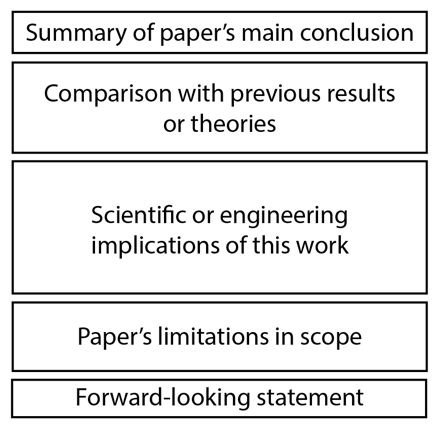Criteria for Success
A strong Discussion section:
- tells the main conclusion of the paper in one or two sentences.
- tells how the paper’s results contribute to answering the big questions posed in the Introduction.
- explains how (and why) this work agrees or disagrees with other, similar work.
- explains how the limitations of this study leave the big questions unanswered.
- tells how extensions of this paper’s results will be useful for answering the big questions.
Structure Diagram

Identify Your Purpose
The Discussion is the part of your paper where you can share what you think your results mean with respect to the big questions you posed in your Introduction. The Introduction and Discussion are natural partners: the Introduction tells the reader what question you are working on and why you did this experiment to investigate it; the Discussion tells the reader what the results of that experiment have to say about the bigger question.
Imagine you explained the results in the paper to a labmate who looks confused and asks you, “Sure, but so what? Why was this cool or interesting?” Your response to your labmate should be similar to the content in the Discussion.
Analyze Your Audience
Different kinds of readers will expect different things from your Discussion. Readers who are not expert in your field might read your Discussion before your Results in the hopes that they can learn what your Results mean and why your paper is important without having to learn how to interpret your experimental results. They might also be interested to know what you think the future of your field is. Readers who are more familiar with your field will generally understand what the results of your experiments say, but they will be curious about how you interpreted confusing, conflicting, or complicated results.
As you write your Discussion, decide who will find each paragraph interesting and what you want them to take away from it. Successful Discussions can simultaneously provide the specific, nuanced information that experts want to read and the broader, more general statements that non-experts can appreciate.
The balance between expert and non-expert readers will depend on the journal you submit to. High-profile, general readership journals will have more non-expert readers, while more technical, field-specific journals can have almost exclusively expert readers.
Skills
Tell how your paper is special
Weak Discussions begin with a summary of the results or a repetition of the main points of the Introduction. Strong Discussions immediately carve out a place for themselves in the large universe of papers by saying what makes this one interesting or special. One way to do this is to start the Discussion with one or two sentences that state the main finding from the results and what that finding means for the field.
Relate your results to existing results
In the Introduction, you probably helped motivate your study by citing previous results in your field. Now that you’ve laid out your results, you should tell whether your results agree or disagree with prior work and why. You might have extended previous work, showed how apparently conflicting results are actually harmonious, or exposed a contradiction that currently has no explanation.
Tell how your study’s limitations leave open the big questions
Every study is finite: you did some things and not others, and you used methods that can explain some phenomena but not others. How do the limitations of your study leave open the bigger questions? Do you just need to do more of the same kind of work? Have you shown that current methods are inadequate to answering the big question?
Every paper is a contribution to a larger scientific conversation. Hopefully, you think your contribution is somehow useful to that conversation: it provides new information or tools that will help you or other researchers move toward answers to the big questions. To explain this contribution, many Discussions end with a forward-looking statement that tries to place the paper in an expected future of research in that field.
